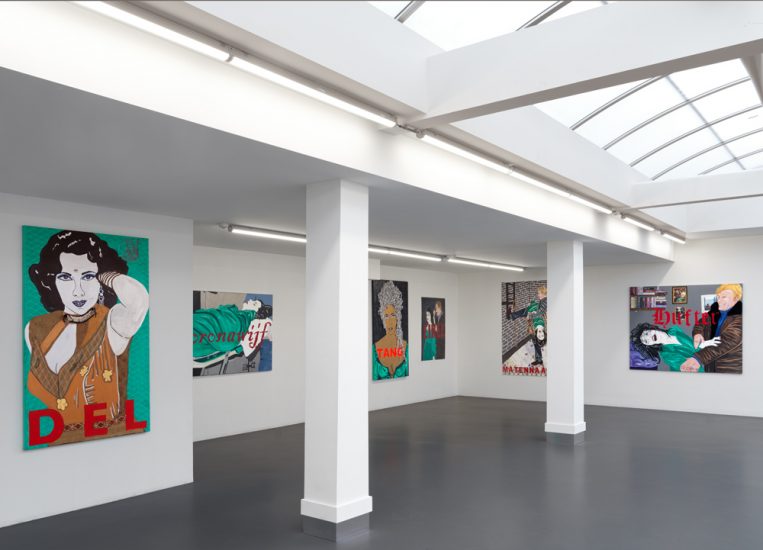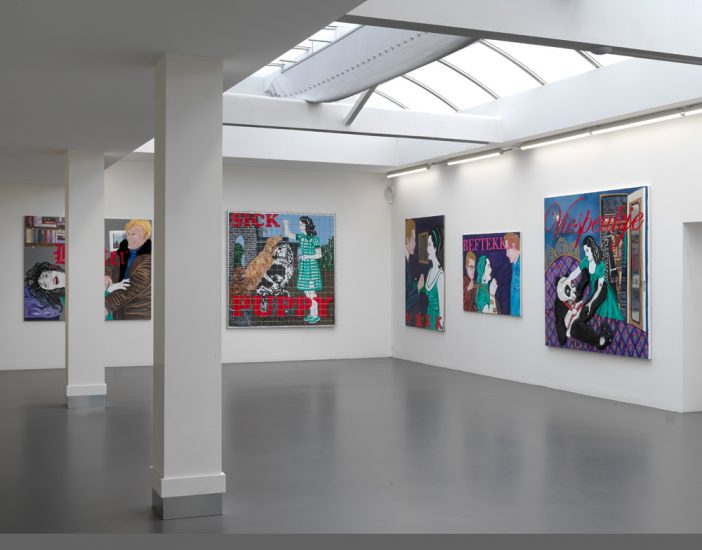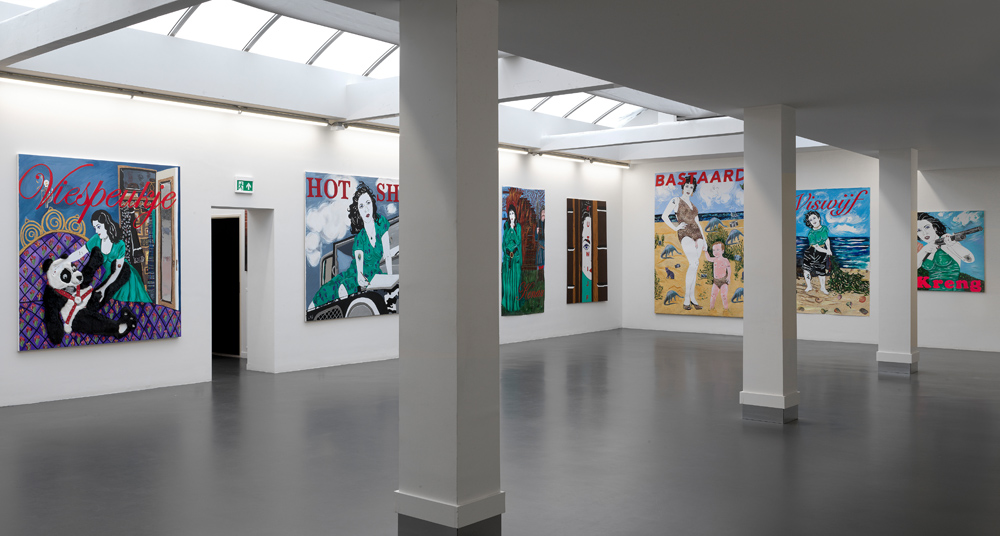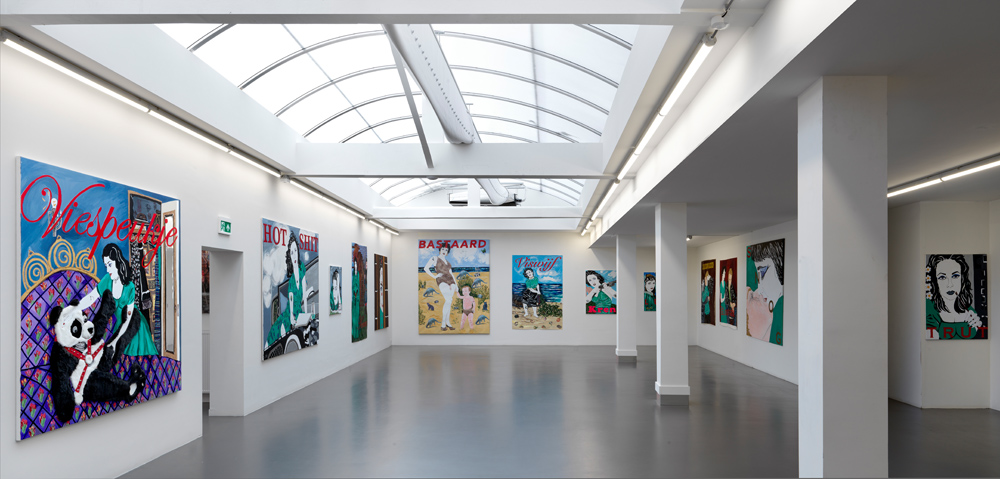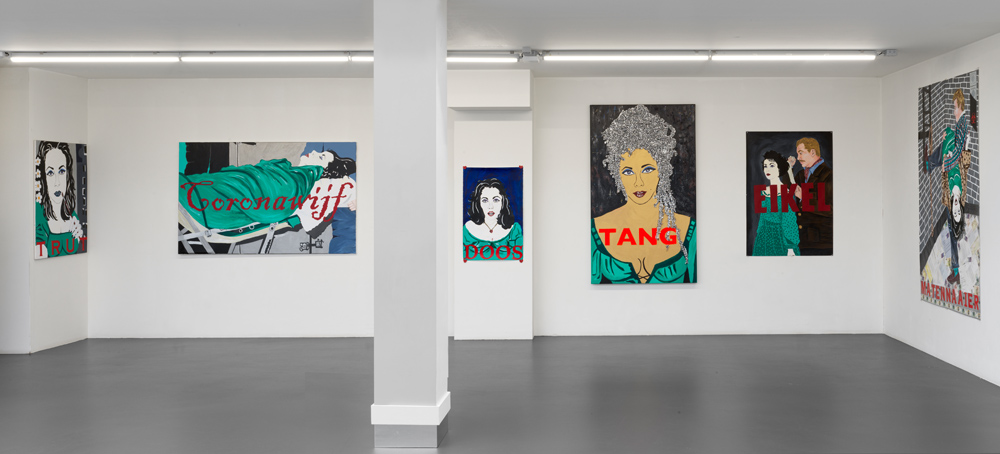Kathe Burkhart
Coronawijf and Other Works
“In women, the self and personal history blends together with the history of all women’
Hélène Cixous
ROZENSTRAAT. a rose is a rose is a rose is very proud to present the solo exhibition Coronawijf and Other Works by Kathe Burkhart. Burkhart is a conceptual artist who is best known for her paintings from the longstanding Liz Taylor Series, but she is also active as a photographer, installation-, video- and performance artist, and as a writer. A critical and feminist approach lies at the heart of all her work. For forty years, Burkhart has resisted still existing clichéd representations of women in her own radical, bold and humorous way. In line with this, her work encourages to reflect on our right to self-determination and our self-chosen identities. At the invitation of Sjoerd Kloosterhuis and Madelon van Schie, Burkhart selected a large part of the ‘Dutch Lizes from the Liz Taylor Series, which she placed as an installation in the space and complemented with a selection of photographs from the HardCore series and a changing selection of videos. It is Burkhart’s first institutional solo presentation in the Netherlands.
Burkhart became fascinated with the powerful and irresistible actress Elizabeth Taylor in the early 80s. Taylor was a rare and liberating role model at the time. For Burkhart, she embodied the ‘bad dark girl’ instead of the ‘good blonde girl’; she was a phallic woman who did not conform to societal norms and ruptured fixed patterns and expectations. In her persona, Burkhart found the ideal Doppelgänger. Or as Burkhart stated herself, ‘I wanted to represent a kind of woman who wasn’t represented, who wasn’t complicit, who was a noncompliant subject with agency.’(…) ‘No personality exemplifies the polarity of bad girl/mother better than Liz Taylor. This alter ego has provided me with a way to represent a certain kind of difference. As a cultural icon, Elizabeth Taylor points up male-defined parameters of female autonomy.’
In the Liz Taylor Series, images of Taylor collide with aspects of Burkhart’s personal history. Be it through the addition of personal elements, such as tax assessments or photographs, or through the similarities between the scene and the artist’s life. The works furthermore serve as a medium to accentuate Burkhart’s own gender non-conforming identity. In the series, we see Liz presented in a variety of dramatic poses and situations, with or without a man and almost always in a characteristic shade of green. Romantic scenes are interspersed with moments of ecstasy, reflection, illness and manipulation. The paintings and drawings from the series, that she started in 1982, are directly inspired by film stills, billboards and tabloid covers. Burkhart has a trove of source materials that she continues to collect and work from. She chooses words and/or images that she strongly identifies with at that particular moment. Using a projector, she enlarges the image and draws it on the canvas in a pop art-like style, grand and in-your-face, after which she continues with paint. The visually rich compositions often include collage elements from hand cut patterns. They attract and amaze, certainly also on account of the artist’s surprising use of materials. With, among other things, adhesive tattoos, fabric, fake fur and jewels, glitter, play money, decorative papers, fences, cable ties, and wood veneer, Burkhart achieves fascinating trompe-l’oeil effects.
At first, however, it’s the provocative texts that Burkhart incorporates into her work as a standard practice that draw the eye. Where you might expect a film title, a swear word, curse or insult appears, often prominently in red block or decorative letters. After a long series of English curses, she continued in Dutch, Italian, Arabic and French; the languages that were spoken in the country she was working in at the time. Each word has its own connotation in terms of gender and time sphere. ‘Kreng’ is mainly used by and for women and ‘Zakkenwasser’ breathes the 80s. Coronawijf: from the Liz Taylor Series (Associated Press clipping) became the title of one of the most recent work in the series. The word just entered in the Dikke Van Dale, and so has been included in the unique and long Dutch tradition of swearing with diseases. The curse words in Burkhart’s work undermine the codes of socially prescribed female behavior and of traditional gender constructions, and thus twist our interpretation of the persons and relationships in the scenes. The words furthermore prompt you to think about who addressed it to whom, but don’t leave out the viewer either. Where do you stand in this scene?
In the series HardCore, which she began in the early 1990s and consists of photographs printed on canvas of sex shop windows in the Red-Light District, Burkhart addresses power relations between men and women (in pornography) as well. Where the artist was initially attracted to the sexual freedom, abundant erotic images and the exotic atmosphere of the Wallen, she soon realized that the environment was not really meant for her. She could buy something but hanging out as long as men did was frowned on. Men could start to feel uncomfortable in front of Burkhart. “I remained on the outside looking in; with my face and my camera pressed as close to the glass as possible to avoid reflection.In the video space, a complete videography will be presented to deepen the exhibition. Some of these works are autobiographical in nature, others have a more satirical and documentary or tableaux approach. Also included are a few recordings of literary readings. As in all her work, these videos too blend the personal with the political.
Kathe Burkhart (1958, U.S.A.) attended the California Institute of the Arts (CalArts) from 1979-1984 where she obtained a BFA and MFA. There she was taught by John Baldessari, Barbara Kruger, Jon Borofsky and Sherrie Levine among others. She also studied political science at the University of Pittsburgh. Burkhart had solo exhibitions at FriArt/Kunsthalle Fribourg; EXILE, Berlin; MoMA PS1; Participant Inc., Mary Boone Gallery, Feature Inc. Fredericks and Freiser (all in New York) among others. Her work was included in group exhibitions The Whitney Museum, New Museum; Brooklyn Museum (all in New York); S.M.A.K. Museum, Gent; The Banff Center for the Arts, Banff; Galleria d’Arte Moderna, Bologna and the 45th Venice Biennale among many others. This fall her work will be on view at CCA Andratx, Mallorca and Baltimore Museum of Art, Baltimore. Currently, her work is also presented in the collection display of the Amsterdam Museum.
Burkhart’s work is included in the collections of the Whitney Museum of American Art, the Art Institute of Chicago en the Stedelijk Museum, Amsterdam, among others. In 2017 the artist received a Guggenheim Fellowship, and in 2022 she was awarded a grant of the Pollock-Krasner Foundation. Burkhart published four books; From Under the 8-Ball (1985), The Double Standard (2002, 2005), Between the Lines (2006) and Dudes (2014). She lives and works alternately in Amsterdam and New York.
ROZENSTRAAT would like to thank Lumen Travo Gallery, the Amsterdam Fund for the Arts and the Mondriaan Fund for their support in organising this exhibition.
Read an essay about the exhibition by Arnisa Zeqo that was commissioned by ROZENSTRAAT here!
Arnisa Zeqo is an art historian, curator and educator based in Amsterdam. She co-founded Rongwrong, a space for art and theory in Amsterdam and is now director of Kunsthuis SYB in Beetserzwaag.
Press:
Het parool, ‘Kunstenares Kathe Burkhart is liever de boze stiefmoeder dan Sneeuwwitje’ by Edo Dijksterhuis, October 17 2022
De Groene Amsterdammer, ‘Viespeukje’, door Joke de Wolf, October 19 2022
